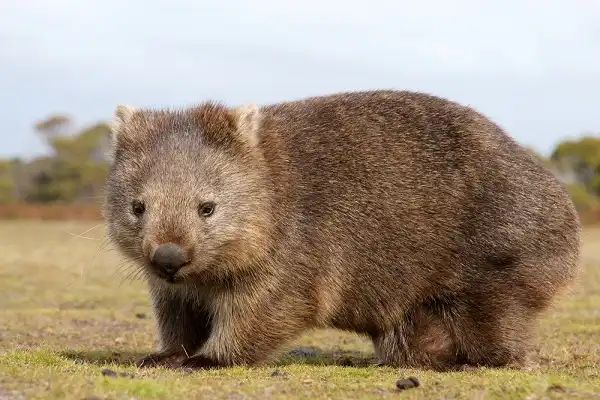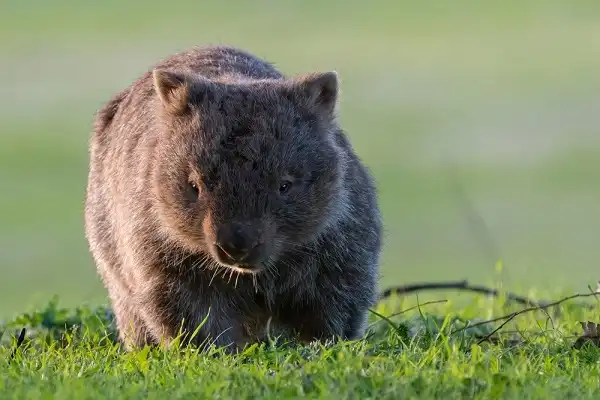The Wombat is a marsupial that inhabits parts of Australia and is known for its stout body, short legs, big feet, and burrowing lifestyle. From its large head to the distinctive flat limbs and long claws clad in thick fur made up of discrete areas of color with ranges including sandy brown to charcoal grey, these nuggets are packed full of interesting personalities that make them unique amongst their smaller mammal relatives. These endearingly charming animals have roots from an ancient lineage steeped in mystery as well as several adaptations that have allowed them to both survive and flourish over time. In this blog post, we will discuss the fascinating biology behind this remarkable species.

Wombat Description
The Wombat, a herbivorous marsupial, is native to Australia and is known for its distinct stout body, short legs, big feet, and burrowing lifestyle. They have a large head with a pointed nose and small ears, and their teeth are long and continuously growing to aid in the grinding of their fibrous diet. Their fur is both dense and silky, and it is composed of separate areas of color that range from sandy brown to charcoal grey. The fur also plays a crucial role in their survival, providing insulation for the various temperatures they experience throughout the year. Wombats are equipped with powerful legs that allow them to move quickly while burrowing through the soil. Their front paws have long, sturdy claws which aid in digging burrows, while they also use their strong hind legs to push soil aside and create tunnels. These burrows offer protection from predators, as well as a cool environment during Australia’s hot summers.
Wombat Habitat
The Wombat is a fascinating creature that is native to the grasslands, forests, and mountainous regions of Australia. These highly adaptable marsupials are found in a variety of habitats, including eucalyptus forests, shrublands, and even coastal regions. In the wild, Wombats prefer to live in areas with plenty of vegetation and a moderate climate. They are well-suited for life in the bush. One of the most striking features of the Wombat is its ability to burrow. These creatures are skilled excavators, and they construct complex underground burrow systems that can cover an area of up to 3 acres! They use their powerful front paws and strong hind legs to dig, and their burrows have multiple entrances and exits, providing them with easy access to their surroundings. Wombats are also excellent swimmers and can hold their breath underwater for up to 90 seconds. They have been known to cross wide rivers and streams, and they use their powerful legs and claws to swim against swift currents.
Wombat Diet
The Wombat’s diet is highly unique and specialized, reflecting their distinctive adaptations to life in the Australian bush. These marsupials primarily feed on grasses, which make up the majority of their diet, along with shrubs and the bark of trees. Their strong jaws and continuously growing teeth are specially adapted for grinding tough plant matter, and they can eat up to 20% of their body weight in a single day! While grasses are their preferred food source, Wombats are known to switch to other types of vegetation depending on their availability. During droughts and other periods of food scarcity, they may consume fungi, sedges, and even small insects. These adaptable creatures are capable of storing fat reserves in their backsides, which can be used as a source of nourishment during times when food is scarce. Despite their herbivorous diet, Wombats have evolved a unique digestive system that allows them to break down tough plant matter. They have a large, chambered stomach that ferments their food, allowing them to extract as much nutrition as possible from their diet. This specialized digestive system also produces dry, cube-shaped feces, which the Wombats use to mark their territory and communicate with other members of their species.

Wombat Size
The Wombat is a stocky, muscular marsupial species that typically measures between 80 and 120 cm in length, with a weight range of 20 to 35 kilograms. They have short, powerful legs with sharp claws, which they use for digging burrows and foraging. Their bodies are covered in thick, coarse fur that ranges in color from sandy brown to dark brown. Male Wombats are generally larger than females, with a more robust build and broader head. They also have a larger scent gland located on their chest, which they use to mark their territory and attract mates. Interestingly, the Wombat’s body size varies depending on its geographical location. Northern Wombats tend to be larger than their southern counterparts, likely due to differences in available food sources and environmental variables.
Wombat Lifespan
Wombats are remarkable creatures that are well adapted to their bushland environment. Along with their unique diet and physical characteristics, their lifespan is also an intriguing aspect of their biology. Wombats typically live for around 15 years in the wild, although some have been known to live up to 20 years in captivity. The lifespan of a Wombat varies depending on several factors, including its habitat and the availability of resources. In general, Wombats living in the wild face more challenges than those in captivity, such as disease, predation, and habitat loss. However, they also have access to natural resources and environmental conditions that can promote their survival. Female Wombats usually have a longer lifespan than males, partly due to their calmer temperament and lower risk-taking behavior. Additionally, Wombats living in protected conservation areas tend to live longer than those in areas with higher human activity.
Wombat Behavior
Wombat behavior is fascinating and varied, showing a range of adaptive strategies to navigate their native bushland environment. Wombats are primarily active at night, using their powerful legs and sharp claws to dig extensive burrow systems for both shelter and protection from predators. Their burrows are also an essential part of their social behavior, with Wombats using their scent glands to mark territories and communicate with others of their species. These burrows can be quite complex and extensive, with some spanning up to 100 meters in length and consisting of several interconnected tunnels. Despite their tough exterior, Wombats are generally docile and shy animals. They have a calm temperament and are not aggressive toward humans unless provoked. They are often seen grazing quietly in open fields, with their stocky, muscular bodies and short, powerful legs making them well-suited for traversing rough terrain. One of the most intriguing aspects of Wombat’s behavior is their relationship with fire. Wombats have been observed using their burrows as a refuge during wildfires, with some individual animals remaining deep underground for days or even weeks until the flames have subsided.

Wombat Speed
Wombats may not be the fastest animals in the animal kingdom, but they are certainly capable of impressive bursts of speed. When threatened, Wombats can run at speeds of up to 40 kilometers per hour. This may not sound like much compared to other speedy creatures, but when you consider their stocky, muscular bodies and short, powerful legs, this feat becomes all the more impressive. Furthermore, Wombats are not built for sustained speed but rather quick bursts of movement, which allow them to evade predators and defend themselves from threats. This unique adaptation is part of what makes these marsupials so successful in their native bushland environment. What’s more, Wombat speed is not their only impressive physical trait when it comes to defense. These animals have thick, tough skin around their hindquarters, which provides an added layer of protection against bites and scratches. When combined with their charging ability, Wombats can be formidable opponents to predators.
Wombat Hunting
Wombats are not known for their aggressive behavior towards humans, but when it comes to defending themselves against predators, they are formidable opponents. With their stocky, muscular bodies and short, powerful legs, Wombats are built for bursts of speed and charging attacks. Their thick, tough skin around the hindquarters also provides an added layer of protection against bites and scratches. Despite these threats, Wombats have a remarkable ability to adapt and survive in their native bushland environment. They are known to retreat to their burrows during wildfires, and some individuals have even been observed modifying their burrows to create fire-resistant chambers. This behavior not only protects them from the immediate danger of the flames but also ensures their survival in the long term by preserving their habitat. In addition to wildfires, Wombats are also threatened by habitat loss and fragmentation caused by human activities such as agriculture, mining, and urban development. Conservation efforts are crucial to protect these iconic marsupials and ensure their long-term survival and success.
Wombat Reproduction
Though Wombats are solitary animals, they do come together for mating. During the breeding season, males will aggressively compete with each other for access to females by butting heads and pushing each other away. After a successful mating session, female Wombats typically give birth to a single joey after a gestation period of approximately 20 weeks. The tiny joey stays in its mother’s pouch for 6 months before it is ready to venture out into the world on its own.

Conclusion
The Wombat is an iconic marsupial species that have evolved impressive physical and behavioral adaptations to survive in its native bushland environment. Its speed, thick skin around the hindquarters, and burrow modification strategies enable it to protect itself from predators while also surviving environmental challenges such as wildfires. Furthermore, Wombats are threatened by habitat loss and fragmentation caused by human activities, making conservation efforts all the more important. Ultimately, we can learn a great deal about these remarkable animals and their resilience in the face of adversity – something that is especially relevant today as we strive to protect and conserve this amazing species.
Frequently Asked Question


